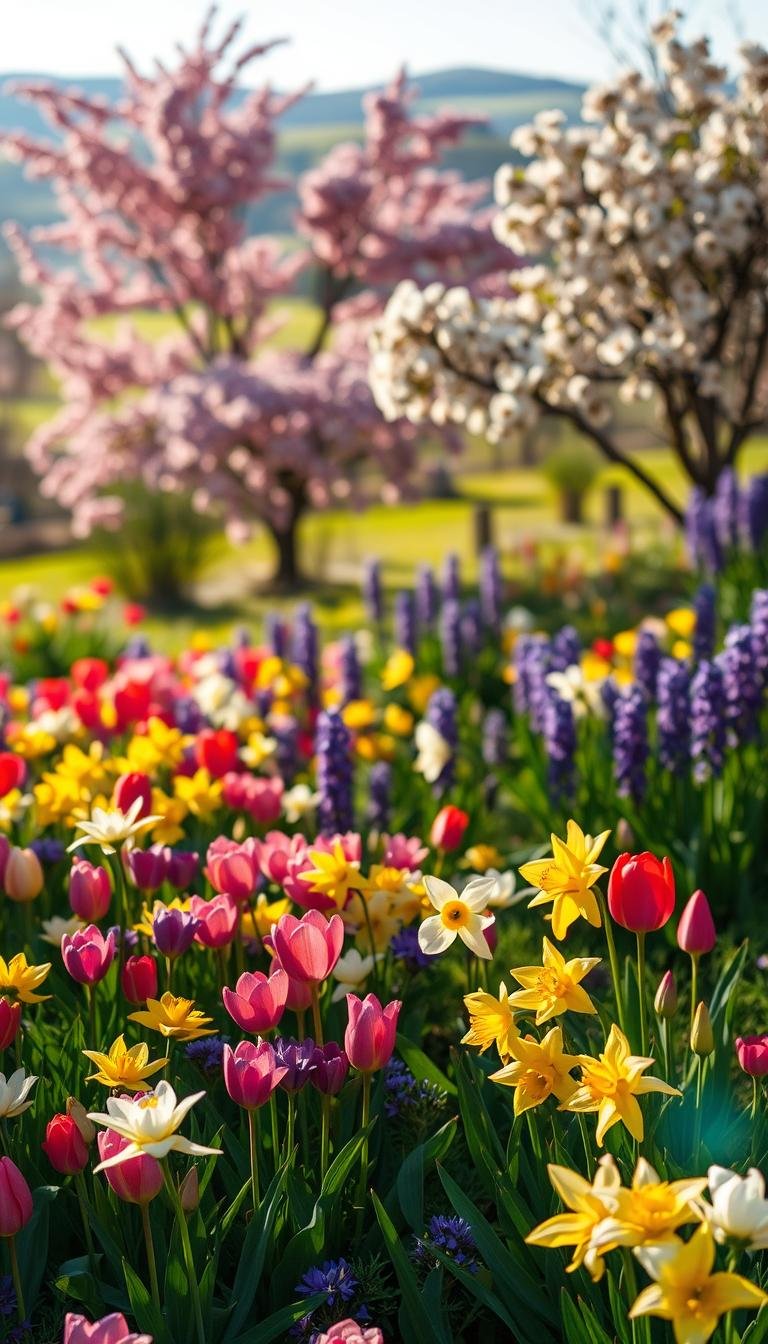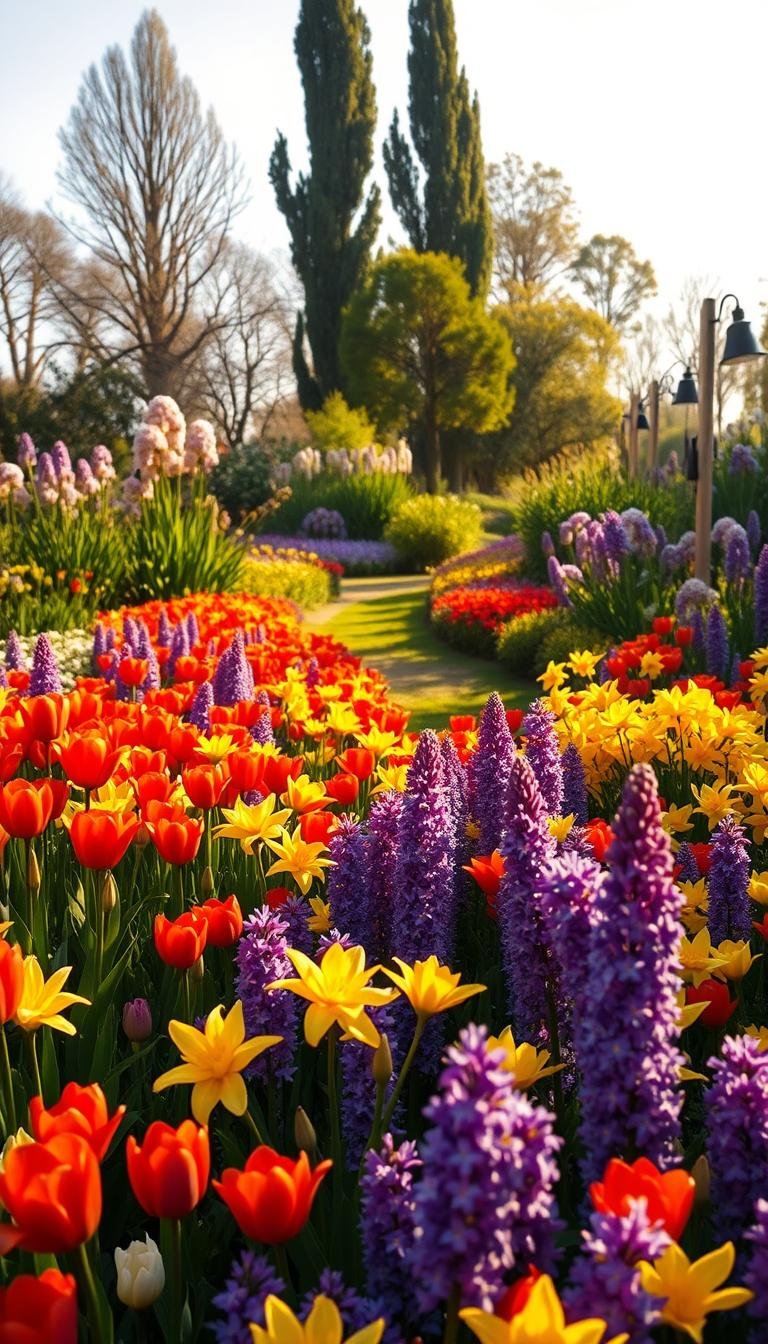This post may contain affiliate links. If you click and buy, we may earn a small commission at no extra cost to you. Learn more.
Growing your own strawberry garden can be very rewarding. Fresh strawberries taste much better than store-bought ones. This guide will help you create a thriving strawberry garden, whether you’re new or experienced.
It covers the basics like choosing the right strawberry varieties and preparing the soil. You’ll learn how to care for your plants. This article will guide you from planting to harvesting. Follow these tips to grow plump, juicy strawberries every year.
Are you ready to harvest your own strawberries? Let’s dive into starting a strawberry garden that’s full of flavor and success. Each section offers practical advice to make your garden a strawberry paradise.
Contents
- 1 Choosing the Right Strawberry Variety
- 2 Preparing Your Garden Soil for Strawberries
- 3 Planting Strawberry Plants: The Best Timing
- 4 Essential Strawberry Care: Watering and Mulching
- 5 Fertilizing Your Strawberry Garden
- 6 Promoting Pollination for Maximum Yields
- 7 Managing Pests and Diseases in Strawberry Gardens
- 8 Harvesting Your Strawberries at the Right Time
- 9 Frequently Asked Questions About Strawberry Gardens
- 10 Enjoying the Fruits of Your Labor
Choosing the Right Strawberry Variety
Choosing the perfect strawberry variety is key to a thriving Strawberry Garden. Whether you’re growing in containers or a backyard, the right variety boosts your harvest. Here are some important factors to consider.
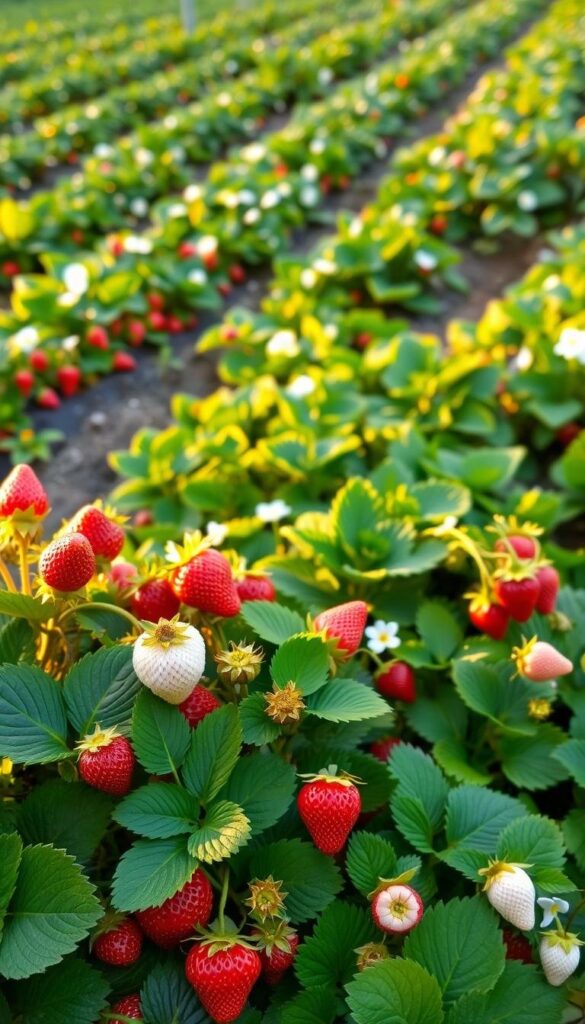
Popular Varieties for Home Gardens
These top performers excel in home settings:
- Chandler: Sweet, firm berries perfect for eating fresh or baking.
- Allstar: Resists diseases and grows well in warm climates.
- Ozark Beauty: Cold-tolerant with bright red fruit for northern climates.
- Alpine: Compact plants ideal for small spaces like pots or window boxes.
Day-neutral vs. June-bearing Strawberries
Day-neutral types fruit all season, while June-bearing offer one big summer harvest. Compare your goals:
- Day-neutral: Continuous berries from spring to fall.
- June-bearing: Higher yield in a single season.
Considering Climate and Space
Match varieties to your region and garden setup:
- Hot climates: Choose heat-tolerant varieties like Allstar.
- Cold zones: Opt for Ozark Beauty or winter-hardy options.
- Small spaces: Alpine strawberries thrive in pots or small beds.
Picking the right variety simplifies growing strawberries and maximizes your harvest. Start with these tips to align plants with your climate and garden style.
Preparing Your Garden Soil for Strawberries
Healthy strawberry plants need soil that’s full of nutrients and drains well. Follow these gardening tips to make your garden a great place for strawberries. First, test your soil’s pH level. Strawberries like a pH between 5.5 and 6.8. You can buy kits at garden centers to check the pH easily.
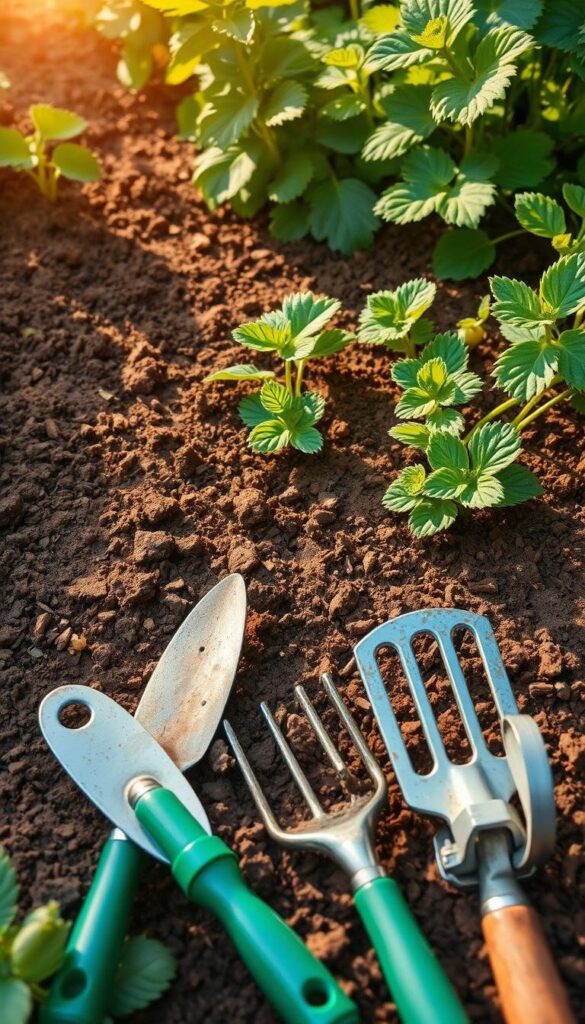
Ideal pH Levels and Nutrients
Make sure your soil’s pH is just right. If it’s too acidic (pH below 5.5), add lime. For too alkaline soil (above 6.8), use sulfur. Strawberries need a mix of nutrients: nitrogen for leaves, phosphorus for roots, and potassium for fruit.
A soil test will show what nutrients are missing. This helps you choose the right fertilizer.
Compost and Organic Matter Integration
Before planting, mix 2–3 inches of compost into the soil. This helps with drainage and adds nutrients slowly. Here are some ideas for your berry garden:
- Mix in well-rotted manure for extra nitrogen.
- Add leaf mold to lighten heavy clay soils.
- Use shredded bark or straw as mulch to keep moisture in.
Good soil is the base for healthy plants. The right pH and organic matter lead to a big harvest. Let the soil rest for 2–3 weeks after adding amendments. This lets the changes take effect.
Planting Strawberry Plants: The Best Timing
Timing is everything for a successful DIY strawberry garden. Planting in spring or fall affects root health and how well you’ll harvest. Here’s how to plant strawberries at the perfect time and do it right.
Spring vs. Fall Planting
In warmer areas, spring planting means berries by summer. But, it needs steady water. For colder places, fall planting strengthens roots. Winter mulch keeps crowns safe from frost.
Check local frost dates to plan. Plant 4–6 weeks before or after frost for the best berries. Northern areas often choose spring to avoid winter damage.
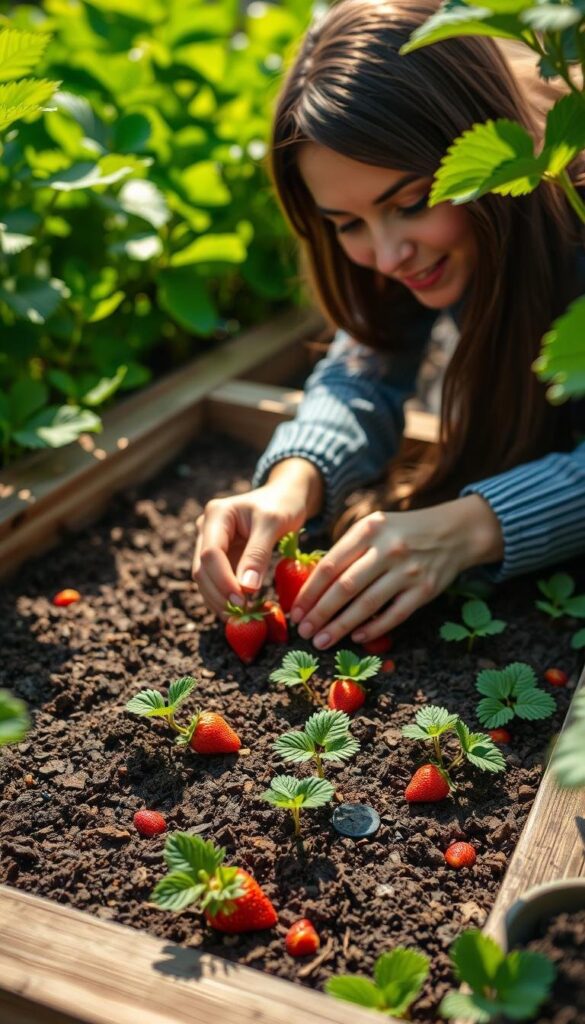
Tips for Planting Depth and Spacing
Here’s how to ensure strong growth:
- Bury roots so the crown is just above the soil—too deep causes rot, too high dries out.
- Space plants 12–18 inches apart to let runners spread without crowding.
- Leave 2–3 feet between rows for matted row systems; 18 inches for hills.
Soak roots in water for 1 hour before planting. Use a trowel to dig holes twice as big as the root ball. Firm soil around roots but don’t compact it.
Essential Strawberry Care: Watering and Mulching
Starting a strawberry garden or keeping one going requires careful watering and mulching. These steps are key to keeping your plants healthy. Let’s explore how to ensure your strawberries thrive at every stage.
Watering is all about finding the right balance. Aim for 1–1.5 inches weekly to keep the roots moist. Here’s how to do it right:
- Use drip irrigation or soaker hoses to avoid wetting leaves and fruit.
- Water deeply once a week, checking soil 2–3 inches deep—if dry, it’s time to water.
- Avoid overhead watering to reduce disease risk like leaf spot or mildew.
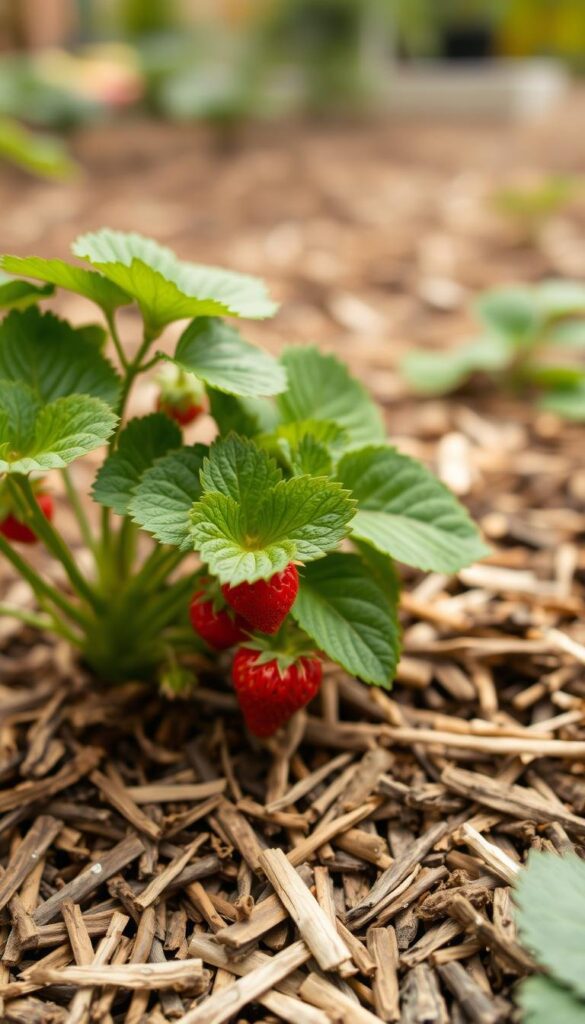
Mulching is essential for protecting roots and boosting yields. Choose from straw, pine needles, or black plastic. Here’s why:
- Strawberry plant care tip: Straw mulch keeps soil cool and prevents fruit rot.
- Black plastic warms soil early in spring but needs shade in hot climates.
- Pine needles add acidity, ideal for strawberries’ soil preferences.
Apply a 2–3 inch layer, leaving a small gap around plant crowns to prevent rot. In colder zones, winter mulch (like straw) protects roots from freezing. Adjust based on your region’s climate!
Fertilizing Your Strawberry Garden
Feeding your Strawberry Garden with the right nutrients keeps plants healthy and productive. The right fertilizer balance is key for strawberry plant care. Let’s look at the best choices and when to use them for delicious berries.
Recommended Fertilizers for Strawberries
Opt for organic or commercial berry-specific fertilizers. Organic options include compost, well-rotted manure, or fish emulsion. For commercial fertilizers, look for balanced N-P-K ratios like 10-10-10 or 8-16-8. Always follow package instructions to avoid overfeeding.
- Nitrogen (N): Boosts leafy growth but too much delays fruiting.
- Phosphorus (P): Encourages root and flower development.
- Potassium (K): Strengthens stems and improves flavor.

When and How to Fertilize
Timing is everything. New strawberry plants need a light dose at planting. Established plants get their first feeding in early spring before blooms appear. After harvest, fertilize June-bearing varieties again in fall. Day-neutral types benefit from monthly spring-summer feedings.
Apply fertilizer 6–8 inches away from plant crowns to prevent burn. Water thoroughly after application. For strawberry plant care, avoid nitrogen-heavy feeds late in the season to prevent winter damage.
Promoting Pollination for Maximum Yields
Strawberries need pollination to grow into sweet berries. Without enough pollinators, flowers might not develop properly. Here are some tips to help every blossom get the pollination it needs.
Attracting Bees and Other Pollinators
Here’s how to attract bees and other pollinators:
- Plant borage, lavender, or alyssum near your strawberries. They attract bees.
- Put a shallow water dish with pebbles near your strawberries. It’s a safe drink spot for bees.
- Don’t spray pesticides when flowers are open. It protects pollinators.
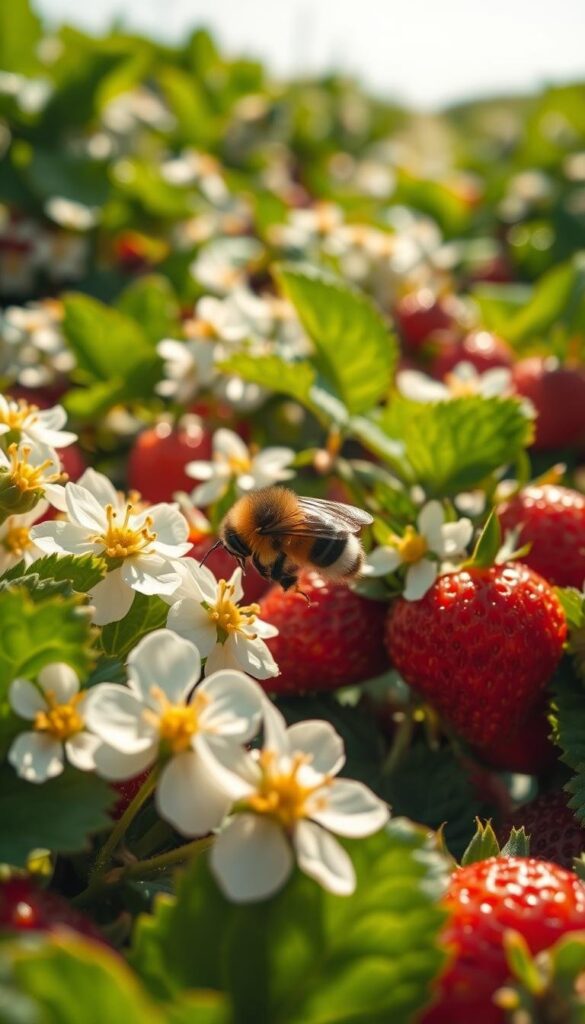
Hand Pollination Techniques
If bees are scarce, you can help. Use a soft brush or cotton swab to:
- Collect pollen from the center of one flower.
- Move it to the center of another flower.
- Do this on sunny mornings when pollen is most active.
Hand pollination is great for container strawberries or greenhouses. A little care can lead to bigger berries when bees aren’t around.
Combining nature and care is key. Invite bees with flowers and help when needed. This approach increases both yield and biodiversity, making every strawberry a success.
Managing Pests and Diseases in Strawberry Gardens
Keeping your DIY strawberry garden safe from pests and diseases is key. Regular checks and quick actions help plants grow strong. This way, you avoid using harsh chemicals.
Common Pests to Watch For
- Slugs and Snails: Use copper tape around plant bases or handpick at night. Organic iron phosphate bait works well.
- Aphids: Blast with water jets or apply insecticidal soap. Encourage ladybugs—they eat aphids!
- Birds: Deter with netting or reflective tape. Scare-eye balloons add visual scare tactics.
- Root Weevils: Check for notched leaves. Treat soil with beneficial nematodes or neem oil.
Effective Disease Prevention Strategies
Prevent disease spread with these steps:
- Prune infected leaves immediately. Destroy debris to stop mold spores from spreading.
- Space plants 12-18 inches apart to improve airflow, reducing humidity that fuels fungi.
- Mulch with straw to keep berries off soil, cutting gray mold risk. Rotate plant locations yearly.
- Choose disease-resistant varieties like ‘Sweet Charlie’ or ‘Cavendish’ to build natural defenses.
For persistent issues, organic fungicides like sulfur or copper sprays can help. Always start with cultural controls first—they’re safer for your garden and family.
Harvesting Your Strawberries at the Right Time
There’s nothing better than eating fresh strawberries from your Strawberry Garden. Picking them at the right time ensures they taste their best. Here’s how to pick your strawberries like a pro.
- Color: Look for fully red berries—no white or green patches.
- Scent: A sweet, fruity aroma signals ripeness.
- Texture: Press gently; ripe berries give slightly but stay firm.
- Season timing: Most varieties ripen 30-40 days after planting strawberries.
Best Practices for Picking
Pick in the morning when berries are cool and crisp. Follow these steps:
- Hold the berry and twist gently to remove it—leave the white cap attached.
- Discard overripe or damaged berries to prevent spoilage.
- Store in a single layer in the fridge for 1-3 days.
- Harvest every 2-3 days during peak season for best results.
Be patient—wait until berries are fully ripe. They won’t sweeten after picking. Keep an eye out for birds or animals eating your strawberries. Share the harvest with friends or use them in recipes for extra fun!
Frequently Asked Questions About Strawberry Gardens
Gardening questions? Let’s clear up common puzzles to keep your plants thriving.
Common Concerns for New Gardeners
- Why aren’t my strawberries producing? Overcrowded plants compete for nutrients. Thin to 12–18 inches between plants and prune extra runners to boost yields.
- Should I cut off runners? Yes! Redirect energy to main plants by trimming runners unless expanding your strawberry plant care setup.
- How long do strawberry plants last? June-bearing varieties peak in year two. Replace every three years for optimal growth.
- Can I grow strawberries in pots? Absolutely! Use 12-inch pots with drainage. Follow how to start a strawberry garden guides for container specifics.
- When should I replace my plants? After three years, replace to avoid disease buildup and soil depletion.
Troubleshooting Tips for Strawberry Issues
Here’s how to fix common problems:
- Small or misshapen berries: Check soil moisture. Water deeply once a week and apply balanced fertilizer in early spring.
- Yellow leaves? Overwatering or nutrient loss. Let soil dry 1–2 inches deep before watering again. Amend with compost yearly.
- Flowers but no fruit? Pollination gaps. Gently shake plants on sunny days or use a soft brush to transfer pollen.
- Flavorless strawberries? Harvest at peak ripeness. Amend soil with compost annually for better sugar development.
Remember, even experts face these challenges! Adjust care steps and keep experimenting—your harvest will thank you.
Enjoying the Fruits of Your Labor
Celebrating your strawberry harvest is the best reward for all your hard work. Whether you’ve learned how to grow strawberries or explored berry garden ideas, picking your first ripe berry is a big moment. It starts a journey of endless culinary adventures.
Delicious Strawberry Recipes to Try
Don’t just use strawberries in desserts. Try them in savory dishes like strawberry salsa with cilantro or strawberry-basil bruschetta. Blend them into smoothies, mix into yogurt parfaits, or even use them in vinaigrettes for salads. Their natural sweetness brings a fresh twist to both sweet and savory meals.
Preserving Strawberries for Later Use
Freeze berries whole or sliced for smoothies and pies later. Make homemade jam using pectin and sugar, or dry them in an oven set to low heat for trail mix. For something unique, simmer strawberries into syrup to drizzle over pancakes or ice cream. Label jars with dates and store properly to enjoy all year.
Every bite of a homegrown strawberry reminds you of the care you put into your garden. Sharing your harvest or enjoying it yourself turns gardening success into lasting memories. With your berries preserved, you’ll enjoy the taste of summer even in winter’s depths.
To bring you cozy inspiration more efficiently, we sometimes use AI to assist in content creation — but every word and idea is carefully shaped by our team. See our AI Disclosure for more info.


